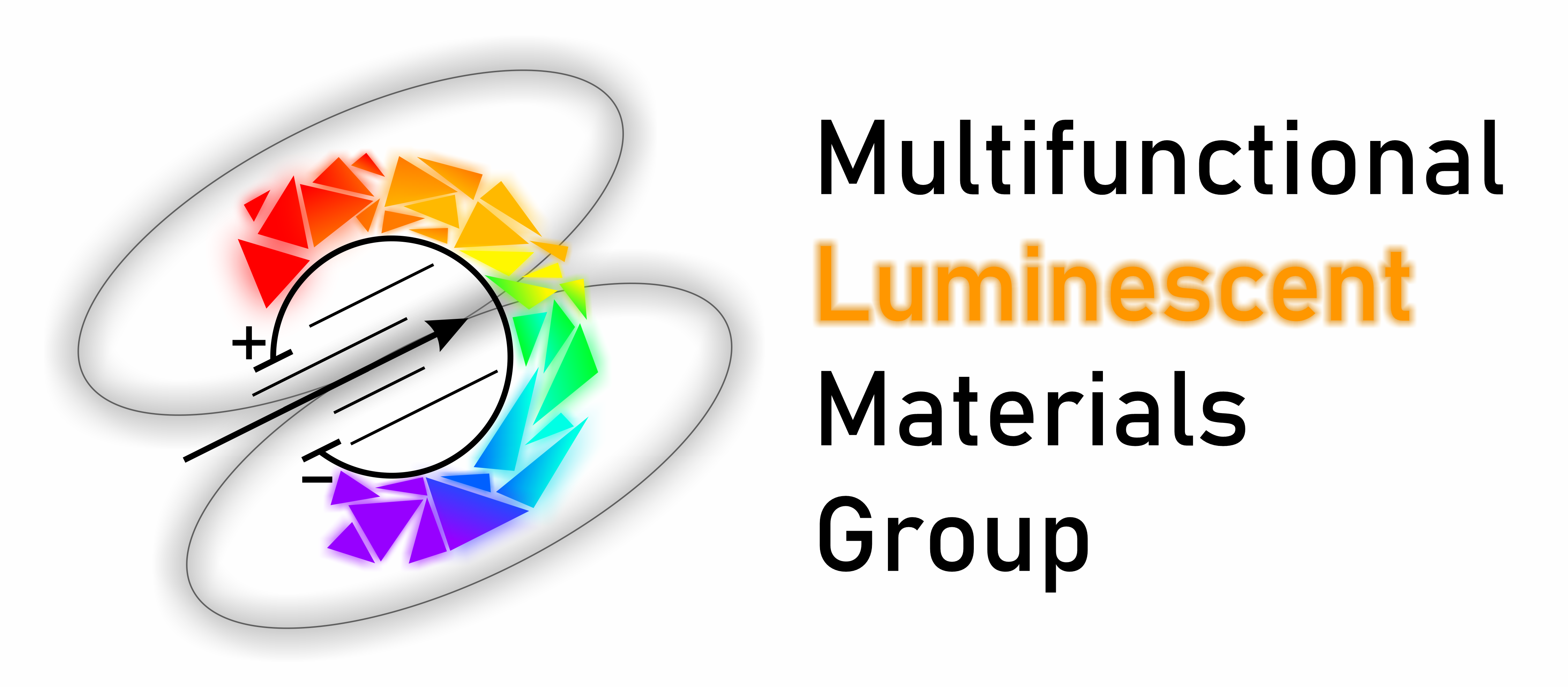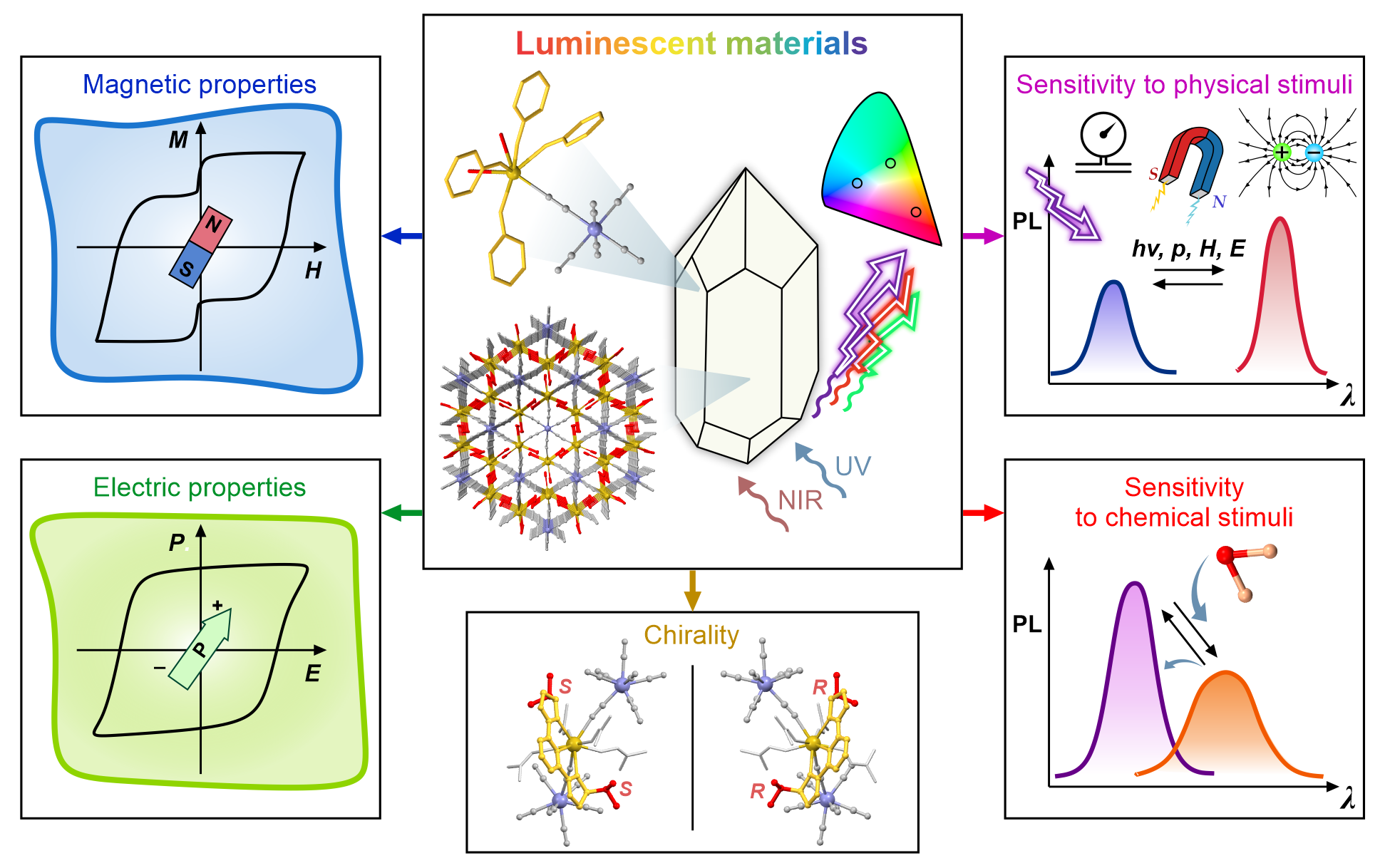Multifunctional Luminescent Materials Group (MLMG)

Group leader:
Dr hab. Szymon Chorąży, prof. UJ
phone: +48 12 686 27 77
e-mail: simon.chorazy@uj.edu.pl
www: http://multilumimater.pl/
Members:
Dr Robert Jankowski (lab manager)
Michał Liberka, MSc (PhD student)
Maciej Wyczesany, MSc (PhD student)
Jakub Zakrzewski, MSc (PhD student)
Mikołaj Żychowicz, MSc (PhD student)
Tomasz Charytanowicz, MSc (PhD student)
Jan Rzepiela, MSc (PhD student)
Agnieszka Puzan, MSc (PhD student)
Aleksander Hoffman, MSc (PhD student)
Kseniia Boidachenko, MSc (PhD, student)
Paweł Bonarek, BSc (MSc student)
Kinga Szczecińska, BSc (MSc student)
Maryia Tamashuk, BSc (MSc student)
Dominika Wolak (BSc student)
Dawid Kruczek (BSc student)
Marta Niemiec (BSc student)
Mikołaj Graff (BSc student)
Jan Sierżęga (BSc student)
Maja Romanowska (BSc student)
Hubert Dziełak (BSc student)
Zofia Szymanowska (BSc student)
Piotr Gas (BSc student)
Research themes
The research interests of Multifunctional Luminescent Materials Group cover the design, synthesis, and thorough physicochemical characterization of diversely functionalized luminescent materials mainly based on metal complexes, with particular attention given to coordination assemblies exploring cyanido (CN–) ligands as intermetallic molecular bridges.
We aim at the new generations of luminescent materials that combine light emission phenomena with various physical functionalities and property-generating features, including magnetic effects (magnetic ordering, molecular nanomagnetism), electric properties (switchable dielectric constant, ferroelectricity, ionic conductivity), non-centrosymmetricity and chirality (for non-linear optical properties and chiroptical effects), and sensitivity to physical (temperature, pressure, electric and magnetic fields, light irradiation, etc.) and chemical stimuli (solvents, gases, guest molecules, see figure below). We are trying to develop unique synthetic strategies for multifunctional luminophores, such as luminescent molecular nanomagnets, emissive molecular ferroelectrics, luminescent proton conductors, chiral luminophores, porous emissive systems, and stimuli-responsive optical and multifunctional opto-electro-magnetic systems. We aim at linking the advantages of luminescent materials, applicable in light-emitting devices, optical communication, photovoltaics, sensors, or bioimaging, with new application horizons originating from the additional physical properties, such as nanomagnetism for high-density data storage devices with the optical output or porosity for highly-sensitive luminescent sensors.
Our main approach is based on the implementation of diverse physical properties within single-phase materials designable at the molecular level. As the result, such materials should become the tool for optical, magnetic, electronic, and multifunctional devices linking high performance with extreme miniaturization. Our group conducts all stages of the research, from the rational design and synthesis, through basic physicochemical characterization, structural studies, up to advanced physical experiments related to optical, magnetic, and electric properties, their combinations, and sensitivity of all these effects to external stimuli within multi-stimuli-responsive systems. We also support the obtained experimental results by theoretical calculations including ab initio and DFT methods.
For more information about the MLMG please visit our website: multilumimater.pl.

Representative publications
-
M. Liberka, M. Zychowicz, J. Hooper, K. Nakabayashi, S. Ohkoshi, S. Chorazy, „Synchronous Switching of Dielectric Constant and Photoluminescence in Cyanidonitridorhenate-Based Crystals”, Angew. Chem. Int. Ed., 2023, 62, e202308284.
-
J. Wang, J. J. Zakrzewski, M. Zychowicz, Y. Xin, H. Tokoro, S. Chorazy, S. Ohkoshi, „Desolvation-Induced Highly Symmetrical Terbium(III) Single-Molecule Magnet Exhibiting Luminescent Self-Monitoring of Temperature”, Angew. Chem. Int. Ed., 2023, 62, e202306372.
-
R. Jankowski, M. Wyczesany, S. Chorazy, „Multifunctionality of luminescent molecular nanomagnets based on lanthanide complexes”, Chem. Commun., 2023, 59, 5961-5986.
-
M. Liberka, M. Zychowicz, W. Zychowicz, S. Chorazy, „Neutral dicyanidoferrate(II) metalloligands for the rational design of dysprosium(III) single-molecule magnets”, Chem. Commun., 2022, 58, 6381-6384.
-
K. Kumar, O. Stefanczyk, S. Chorazy, K. Nakabayashi, S. Ohkoshi, „Ratiometric and Colorimetric Optical Thermometers Using Emissive Dimeric and Trimeric {[Au(SCN)2]–}n Moieties Generated in d–f Heterometallic Assemblies”, Angew. Chem. Int. Ed., 2022, 61, e202201265.
-
J. Wang, J. J. Zakrzewski, M. Zychowicz, V. Vieru, L. F. Chibotaru, K. Nakabayashi, S. Chorazy, S. Ohkoshi, „Holmium(III) molecular nanomagnets for optical thermometry exploring the luminescence re-absorption effect”, Chem. Sci., 2021, 12, 730-741.
-
J. J. Zakrzewski, K. Kumar, M. Zychowicz, R. Jankowski, M. Wyczesany, B. Sieklucka, S. Ohkoshi, S. Chorazy, „Combined Experimental and Ab Initio Methods for Rationalization of Magneto-Luminescent Properties of YbIII Nanomagnets Embedded in Cyanido/Thiocyanidometallate-Based Crystals”, J. Phys. Chem. Lett., 2021, 12, 10558-10566.
-
R. Jankowski, J. J. Zakrzewski, M. Zychowicz, J. Wang, Y. Oki, S. Ohkoshi, S. Chorazy, B. Sieklucka, „SHG-active NIR-emissive molecular nanomagnets generated in layered neodymium(III)–octacyanidometallate(IV) frameworks”, J. Mater. Chem. C, 2021, 9, 10705–10717.
-
M. Liberka, J. J. Zakrzewski, M. Heczko, M. Reczyński, S. Ohkoshi, S. Chorazy, „Solvent- and Temperature-Driven Photoluminescence in Porous Hofmann-Type SrII–ReV Metal–Organic Frameworks”, Inorg. Chem., 2021, 60, 4093-4107.
-
J. Wang, J. J. Zakrzewski, M. Heczko, M. Zychowicz, K. Nakagawa, K. Nakabayashi, B. Sieklucka, S. Chorazy, S. Ohkoshi, „Proton Conductive Luminescent Thermometer Based on Near-Infrared Emissive {YbCo2} Molecular Nanomagnets”, J. Am. Chem. Soc., 2020, 142, 3970-3979.
-
S. Chorazy, T. Charytanowicz, D. Pinkowicz, J. Wang, K. Nakabayashi, S. Klimke, F. Renz, S. Ohkoshi, B. Sieklucka, „Octacyanidorhenate(V) Ion as an Efficient Linker for Hysteretic Two-Step Iron(II) Spin Crossover Switchable by Temperature, Light, and Pressure”, Angew. Chem. Int. Ed., 2020, 59, 15741-15749.
-
S. Chorazy, J. J. Zakrzewski, M. Reczyński, B. Sieklucka, „Multi-colour uranyl emission efficiently tuned by hexacyanidometallates within hybrid coordination frameworks”, Chem. Commun., 2019, 55, 3057-3060.
-
J. J. Zakrzewski, S. Chorazy, K. Nakabayashi, S. Ohkoshi, B. Sieklucka, „Photoluminescent Lanthanide(III) Single-Molecule Magnets in Three-Dimensional Polycyanidocuprate(I)-Based Frameworks”, Chem. Eur. J., 2019, 25, 11820-11825.
-
Y. Xin, J. Wang, M. Zychowicz, J. J. Zakrzewski, K. Nakabayashi, B. Sieklucka, S. Chorazy, S. Ohkoshi, „Dehydration–Hydration Switching of Single-Molecule Magnet Behavior and Visible Photoluminescence in a Cyanido-Bridged DyIIICoIII Framework”, J Am. Chem. Soc., 2019, 141, 18211-18220.
-
S. Chorazy, J. J. Zakrzewski, M. Reczyński, K. Nakabayashi, S. Ohkoshi, B. Sieklucka, „Humidity driven molecular switch based on photoluminescent DyIIICoIII single-molecule magnets”, J. Mater. Chem. C, 2019, 7, 4164-4172.
Cooperation opportunities
Those of you who are interested in the research on novel luminescent materials showing diverse physical properties combined with light emission phenomena are asked to contact dr hab. Szymon Chorąży (simon.chorazy@uj.edu.pl).

